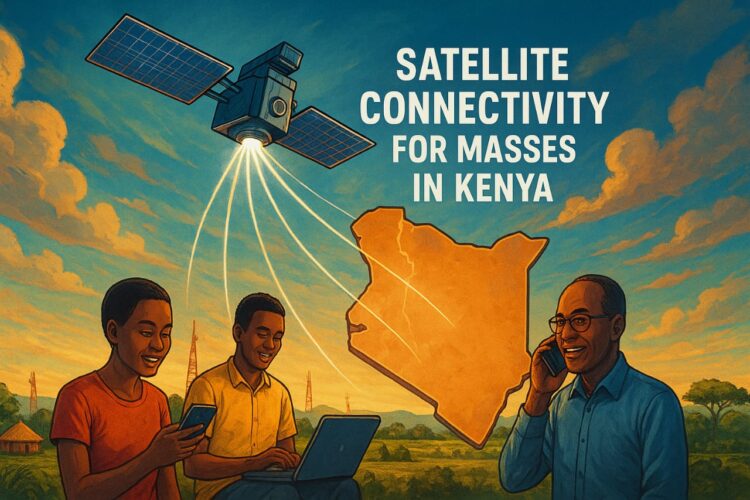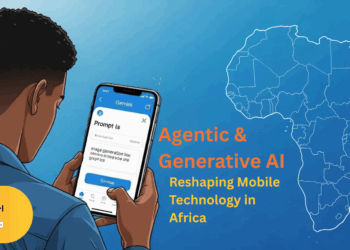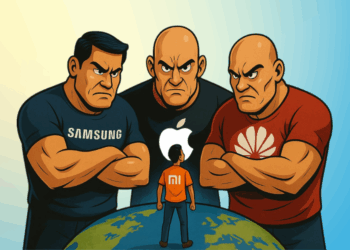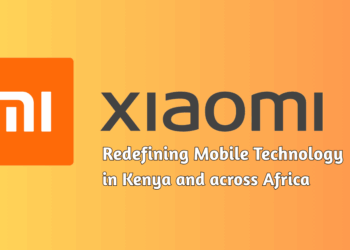New Possibilities with Satellite Connectivity
Satellite connectivity for masses in Kenya is no longer a distant dream — it’s a lifeline pulsing through the country’s most remote corners. In Marsabit, a nurse can tap her Pixel Watch to send an SOS in the event of a medical emergency. In Turkana, a herder checks satellite-fed weather updates before moving his livestock across arid plains. No mobile towers. No fiber cables. Just the sky — and the signal it now carries.
What if the future of African connectivity isn’t built on towers, but on satellites?
As Kenya leads the charge into this new frontier, the ripple effect is unmistakable — echoing across Africa from the Sahel to the Serengeti. This isn’t just a tech upgrade. It’s a shift in how communities live, work, and survive. And it’s happening above us, one orbit at a time.
The Connectivity Gap in Kenya
Despite Kenya’s reputation as a tech-savvy hub, satellite connectivity in Kenya is emerging not because of luxury, but necessity. Over 17 million Kenyans still live in areas with limited or no reliable mobile broadband, according to recent ICT sector reports. Counties like Turkana, Marsabit, Samburu, and parts of Garissa remain underserved due to harsh terrain, sparse populations, and the prohibitive cost of erecting mobile towers.
This digital divide isn’t just inconvenient — it’s dangerous. In Marsabit, a medical emergency can mean a two-hour wait for help simply because a nurse can’t place a call. Floods displace families in Baringo who have no way to alert rescue teams. In northern Isiolo, students walk kilometers to access internet hotspots for online learning. When the Tana bursts its riverbanks and causes havoc, it is always a disaster in Garissa, Tana Country, and the low-lying Tana Delta.
Traditional infrastructure has hit its ceiling. Fiber cables don’t stretch across deserts. Towers don’t climb mountains. And yet, the need to connect — to learn, to trade, to survive — grows louder by the day.
Satellite connectivity offers a new answer—one that doesn’t rely on proximity to a mast, but on access to the sky. And as Kenya begins to bridge this gap, the rest of Africa watches — ready to follow from the Sahel to the Serengeti.
What Is Satellite Connectivity?
First things first. Let’s start with key definitions around satellite connectivity.
Satellite connectivity enables devices such as smartphones, watches, and vehicles to send and receive data directly via satellites — eliminating the need for cell towers or fiber cables. It’s a game-changer for remote regions in Kenya where traditional mobile networks fall short.
Modern satellite systems utilize Low Earth Orbit (LEO) satellites, which orbit approximately 1,000 kilometers above Earth. Their proximity enables faster, more reliable connections with lower latency. Unlike older satellites, LEOs can support real-time messaging, GPS tracking, and even internet access.
Thanks to 3GPP Release 17, a global telecom standard, satellite networks now integrate seamlessly with mobile devices. This enables Direct-to-Device (D2D) communication — meaning phones like the Pixel 10 and wearables like the Pixel Watch 4 can send SOS alerts or location data via satellite, even in total network blackouts.
Key players driving this shift include SpaceX (Starlink), Skylo Technologies, Geely’s Geespace, and Google. Their innovations contrast sharply with traditional mobile networks, which rely on costly ground infrastructure and offer limited rural coverage.
Satellite connectivity isn’t replacing mobile networks — it’s extending them. For Kenya, this means universal access, faster emergency response times, and new digital opportunities in places once considered unreachable.
Real-World Use Cases in Kenya
Satellite connectivity in Kenya is no longer theoretical — it’s transforming lives in areas where mobile signals are scarce and fiber cables are impractical.
Wildlife and Conservation
In the heart of Tsavo, ranger teams patrol vast terrain where poachers exploit communication blackouts. With satellite-enabled Pixel 10 devices, rangers can now send real-time alerts and GPS coordinates to command centers, even in the most remote areas. This tech isn’t just saving elephants and Rhinos — it’s saving lives.
Healthcare
In Marsabit, a nurse at a remote dispensary faces a medical emergency. With no mobile coverage, she can activate her Pixel Watch 4 to send an SOS via satellite. Within minutes, a rescue team is mobilized. Clinics across Samburu and Turkana are beginning to adopt satellite-ready devices to transmit patient data and coordinate referrals — bridging the healthcare gap.
Pastoralist Mobility
Nomadic herders in Isiolo and Baringo rely on weather updates and livestock market prices to plan their movements. Satellite-connected rugged phones now deliver this data directly, helping families avoid drought zones and optimize trade routes. It’s digital empowerment for communities that have long been left behind.
Moreover, the pastoral communities have faced the menace of bandits attacking them and stealing their livestock. Through satellite communication, security can be improved. Better coordination can be achieved through the combined efforts of government, local leadership, and communities to help galvanize the security and well-being of the people.
Education & NGOs
In West Pokot, students gather around a satellite-linked tablet to access e-learning modules. NGO field workers in Garissa use satellite dashboards to coordinate relief efforts and track supplies. Connectivity is no longer a privilege — it’s a tool for resilience.
From conservation to classrooms, satellite connectivity is stitching together Kenya’s disconnected edges — one signal at a time.
Devices Powering the Shift
As Kenya confronts its connectivity gap, a new generation of satellite-ready devices is rewriting the rules of access. From flagship smartphones to rugged field gear, these tools are no longer niche — they’re becoming essential.
Google’s Pixel 10 Series, now equipped with Skylo-powered satellite messaging, enables SOS alerts, GPS sharing, and two-way communication in dead zones — even without cellular coverage. The Pixel Watch 4, the world’s first smartwatch with standalone satellite emergency messaging, offers wrist-based access to rescue services, powered by Qualcomm’s Snapdragon W5 Gen 2 chip. Others may follow as Snapdragon W5 Gen 2 rolls out to more brands.
Meanwhile, rugged phones like the Ulefone Armor 23 Ultra and Doogee V30T integrate satellite GPS and emergency pinging — ideal for Kenya’s remote counties. Vehicle-integrated systems in logistics and safari fleets now feature satellite-linked dashboards for real-time tracking and distress signaling.
Mini Comparison Snapshot
| Device | Key Feature | Satellite Support |
| Pixel 10 | SOS, GPS, Messaging via Skylo | Skylo + Starlink |
| Pixel Watch 4 | Wrist-based emergency messaging | NB-NTN Satellite |
| Ulefone Armor 23 | Rugged build, GPS pinging | Emergency satellite GPS |
| Vehicle Dash Units | Fleet tracking, SOS button | Integrated satellite modems |
With rapidly advancing technology and shifting consumer needs, more Kenyans in remote regions will no longer be isolated. These devices are not just tech upgrades — they’re lifelines. They unlock new possibilities for telemedicine, e-learning, disaster response, and market access in places once considered unreachable. A farmer in West Pokot can now receive weather alerts. A student in Samburu can join a virtual classroom. A tour operator in Tsavo can track vehicles across vast terrain.
Affordability is shifting, too. Satellite-ready phones now retail under KES 40,000, and wearable plans bundle satellite access with mobile data. As coverage expands and costs drop, satellite connectivity is no longer a luxury — it’s a strategic enabler of inclusion, resilience, and innovation.
Select Smartphones with Satellite Connectivity
| Brand | Model(s) | Satellite Features |
| Pixel 10 Series | First to support WhatsApp audio/video calls via satellite | |
| Pixel 9 Series | Emergency SOS and location sharing via the Skylo satellite network | |
| Apple | iPhone 14, 15, 16 Series | Emergency SOS via Globalstar; location sharing in remote areas. |
| Samsung | Galaxy S25 Series | Two-way satellite messaging via Skylo (US only) |
| Huawei | Mate 50, Mate 60 Pro, Pura 70 Ultra | Satellite messaging and image sharing via BeiDou |
| Xiaomi | 14 Ultra, 15 Pro, MIX Fold 4 | Two-way satellite messaging |
| Motorola | Defy 2 | Rugged phone with MediaTek satellite chipset for SMS in remote zones. |
| OnePlus | OnePlus 11 | Emergency satellite messaging expected |
| Oppo | Find X8 Pro Satellite Edition | Satellite messaging support |
| Honor | Honor X60 | Satellite messaging support |
If you work in these remote areas or own an organization that operates in vast regions with problematic mobile connectivity, investing in modern smartphones and devices that enable satellite connectivity-based communication is worthwhile.
JuaTech Africa stands at the intersection of this transformation — decoding the tech, guiding readers, entrepreneurs, Governmental, and NGO leaders who are inclined towards making a difference in otherwise remote and inaccessible areas. We feel honored to empower communities to harness the full potential of satellite-powered progress.
Strategic Implications for Retailers & Tech Creators
Satellite-ready devices aren’t just tech upgrades — they’re lifelines. For Kenyan retailers, this is a golden moment to reposition gadgets as connectivity solutions for NGOs, tour operators, rural buyers, and logistics firms navigating off-grid terrain. A Pixel 10, Ulefone Armor 23 Ultra, and other satellite-connected devices are not just smart devices — they are rescue tools in Samburu, data lifelines in Turkana, and market enablers in Garissa.
Retailers must train their sales representatives to sell impact, not just specifications. It’s no longer about megapixels and RAM — it’s about whether a device can send an SOS from a flooded village or deliver market prices to a herder in Wajir. It may mean a taste of the real situation on the ground, as these gadgets are marketed and sold to users who have to work or live in such environments.
JuaTech Africa is leading this shift, equipping retailers with persona-driven pitch decks, training modules, and content that speaks the language of real-world utility. As technology evolves, we take an active role as enablers, unlocking possibilities through simplification and adaptability.
Creators, too, have a role to play. TikTok demos, led by leaders and influencers, showing students in West Pokot accessing e-learning via satellite, or a ranger sending alerts from Tsavo, can spark mass awareness. Retail guides, short-form storytelling, and influencer-led campaigns can turn tech into testimony, especially around the benefits of satellite connectivity.
This isn’t just business — it’s transformation—hundreds of jobs in retail, training, and content creation. Thousands of lives improved through access, safety, and opportunity. Kenya’s entrepreneurial spirit thrives when tech meets purpose — and satellite connectivity is the next frontier.
Satellite Connectivity for Masses| Pan-African Potential & Future Outlook
From the plains of Kajiado, across the vast, rugged terrain of the Rift Valley to the highlands of Ethiopia, satellite connectivity is unlocking a new frontier for Africa’s underserved regions. What began in Kenya — empowering rangers, herders, and remote clinics — is now scalable across East Africa: Tanzania’s wildlife corridors, South Sudan’s humanitarian zones, and Ethiopia’s rugged terrain all stand to benefit.
The future is even brighter. Satellite IoT will connect irrigation pumps in arid farms. Vehicle-to-satellite networks will guide trucks across borderless logistics routes. Smart agriculture will thrive in areas where mobile towers have yet to reach.
JuaTech Africa is poised to lead this transformation — not just as a tech educator, but as a regional thought leader. Through content, consulting, and creator-led storytelling, we’re shaping how Africa adopts off-grid tech with purpose. This isn’t just innovation — it’s inclusion, resilience, and economic rebirth for millions.
Africa’s next leap won’t be wired. It’ll be satellite-powered — and community-driven.
Conclusion and Call to Action
Connectivity is no longer a luxury — it’s dignity, safety, and opportunity. From rangers deep in Tsavo working to save endangered wildlife from poachers, to students in West Pokot accessing e-learning, to rescue teams saving lives in remote areas, satellite-ready devices are rewriting the story of access across Kenya. They’re enabling SOS calls, market insights, remote learning, and life-saving healthcare — all from places once considered unreachable.
This is the moment for retailers, creators, and changemakers to lean in. Explore satellite-ready devices. Train your teams to sell impact, not just specs. Follow JuaTech Africa’s content series for insights, demos, and buyer guides. Partner with us to build retail strategies, creator campaigns, and training programs that empower communities and unlock new markets.
We’re not just connecting devices — we’re connecting destinies. The ripple effect touches livelihoods, employment, education, and resilience.
In Kenya, the sky is no longer the limit — it’s the lifeline.

















